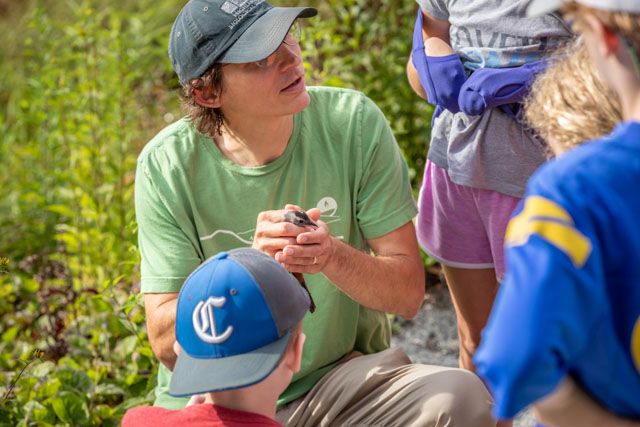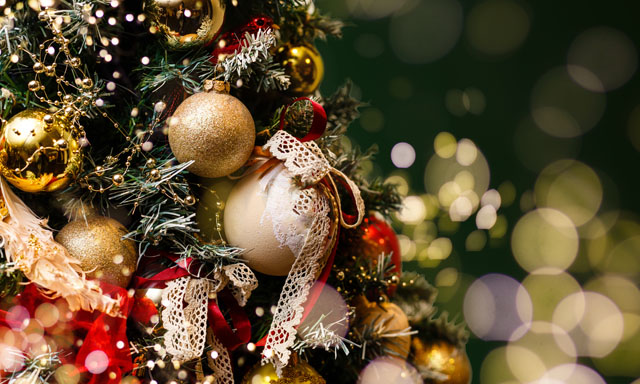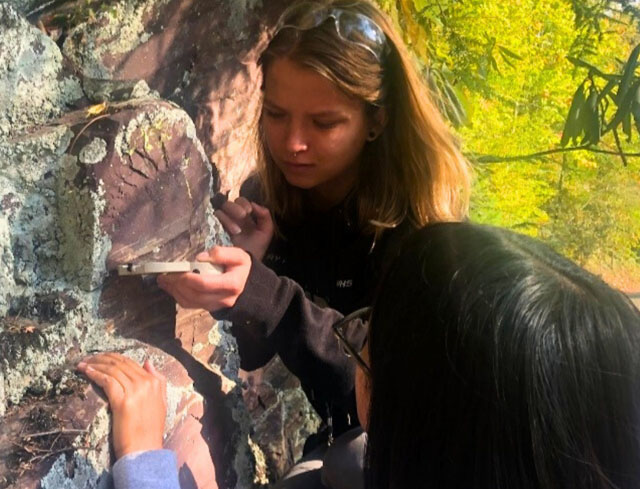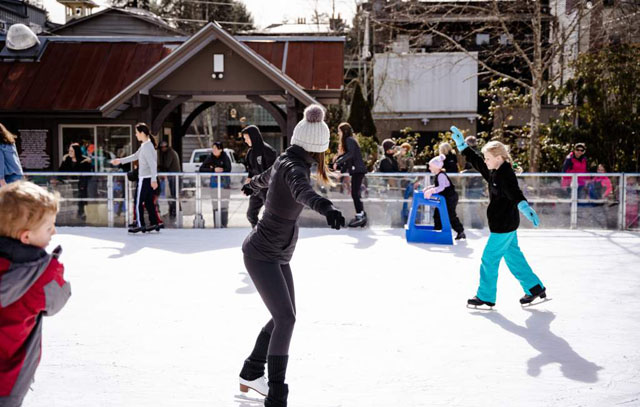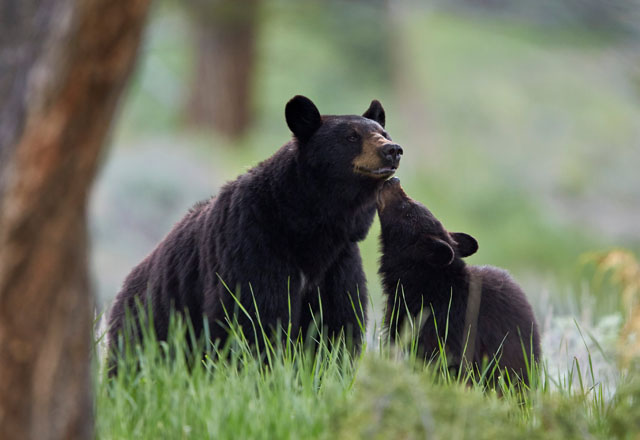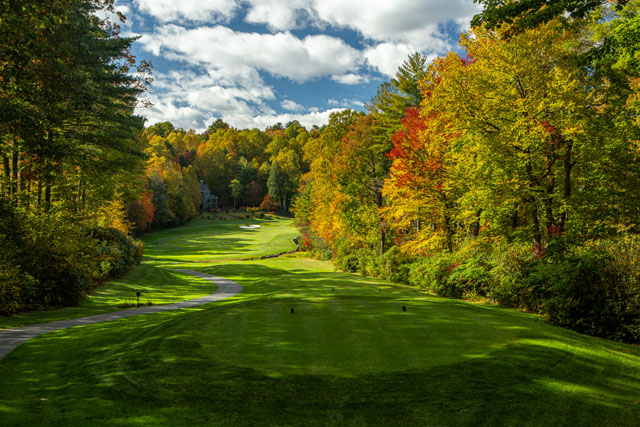The Innate Creative
02 Aug 2023
Local artists share their knowledge of creativity
Story by LISA GRAY YOUNGBLOOD

One of the most beautiful mysteries of the universe is creativity. What is it? Where does it come from? How does one find and harness it? I believe all humans are creative. In fact, I believe we were born to create. Perhaps creations are a gift to each other, to the larger world, to ourselves or to our maker. Whatever their purpose, however, I believe they arise from our most pure, most natural state.
Creativity comes in many forms. If you enjoy cooking and ever dabble on the outskirts of a recipe, if you have ever whittled raw wood into a new shape, planted a garden, found a unique solution to a pesky problem, or set a table with flowers you arranged yourself, you are a creative. Welcome to the club. It is a wondrous one.
Some among us, of course, are well into their creative journeys and have explored creativity in great depth. At Plateau Magazine, we have the pleasure of featuring such artists in every issue, and I decided to lean on a few to learn more. I asked each of them to reflect upon the nature and source of creativity as well as their method of harnessing it. Their answers have inspired and surprised me, opening my mind to the expansiveness of creativity. As a fiction writer, every story I have ever written has come to me in the same way, which led me to believe, erroneously, that I had stumbled upon a universal path to creativity. I had not. I had only discovered my personal path, a realization that has magnified my curiosity about the mysteries of creativity.
Perhaps one of the paths below will inspire and encourage you on your own journey.
Mysticism, Then Muscle
RON RASH, Author
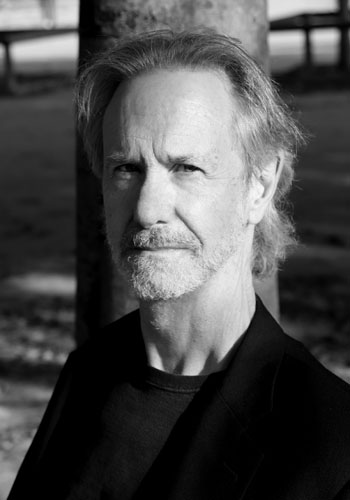
When writing fiction, the worst thing I can have is an idea, for the process becomes labored and controlled rather than organic. Instead, my novels and short stories begin with a single image. With my novel Serena, the image was of a woman on horseback. Her erect, confident carriage depicted someone very much in control. I also knew a man was watching her, with equal parts fear and love. In my short story, The Ascent, I had an image of a child in a snowy forest. He had come upon a plane wreck and despite the horrific scene, he was not terrified.
As to the source of the images, I have some Jungian notions, but ultimately, I don’t know the why or the how. I do know that it feels as though I have been glimpsed something that already exists. The story begins to emerge. At times the narrative seems to be telling itself, and I am frantically trying to get it written down before it disappears. When this occurs, I tend to be in my story’s world more than my own, as my friends and kin attest. I hear my characters’ voices. One afternoon while teaching after a morning of writing, I caught myself using one of my character’s colloquialisms, “like as if,” instead of “as if.”
Working without ideas or outlines can be frustrating, and I sometimes wish I were like other writers I know who begin with a sturdier sense of where a narrative is going. Almost every novel I’ve written comes to a seemingly dead end, often after a year of work. Michelangelo believed the completed statue was within the unhewn block of marble. I make myself believe the image that triggered the novel will lead me the rest of the way. Somehow, it always seems to do so, and when the story is clear I’m free to focus on the language—which syllables to stress in a sentence, more resonant verbs. I always do a number of drafts, but it is never drudgery. This is the part of writing I enjoy most, a reprieve after so much uncertainty and vexation.
BIO: Ron Rash is the author of the PEN/Faulkner finalist and New York Times bestselling novel Serena, in addition to the critically acclaimed novels The Risen, Above the Waterfall, The Cove, One Foot in Eden, Saints at the River, and The World Made Straight; five collections of poems; and seven collections of stories, among them Burning Bright, which won the 2010 Frank O'Connor International Short Story Award, Nothing Gold Can Stay, a New York Times bestseller, and Chemistry and Other Stories, which was a finalist for the 2007 PEN/Faulkner Award. Three times the recipient of the O. Henry Prize, his books have been translated into seventeen languages. He teaches at Western Carolina University. His new novel, The Caretaker, will be published by Doubleday this September.
An Unveiling
MARY PALMER DARGAN, Landscape Architect

As a landscape architect, I'm blessed with an intuitive, artistic gift for seeing the potential in undesigned or chaotic places, a gift honed by over 45 years of looking at properties. I use a technique of quiet reflection to get under the skin of my project.
Typically, I'm rushed for time while at a new site, and noisy chaos is everywhere. While on my walkabout, I look for a five-minute sit, quickly take a few deep breaths and focus on my third eye. Here, a fleeting dreamlike state behind my eyes settles into the center of my brain. With my five senses tuned up, I drift into this piece of nature to find its spark of personality or coax its spirit of place into being.
If my pad of paper is handy, I'll take the mental image and draw it immediately in a childlike effort to capture the vision. Yes, I do use art elements, having been well-schooled in them, and as a result they are part of my design consciousness. For instance, a mental desire line to move around and past a tree becomes a path but mimics the line of the creek beyond. A mountain in the distance is the color of slate blue and touches other mountains that are billowing grey green. I think in terms of "laying" these colors down on the field canvas by using harmoniously colored plant material. Getting into the zone is as individualized as the fingerprint of the place.
As to the source of this creativity, I think it comes from above and into the center of my mind. I rarely preconceive my designs.
For anyone interested, Mary Reynolds, an Irish landscape architect, has wonderful ways to connect with your place in her book, The Garden Awakening: Designs to Nurture Our Land and Ourselves.
BIO: Mary Palmer Dargan, a licensed landscape architect since 1982, creates beautiful, relaxing havens across the world for homeowners. Her flagship 3-part course, The Placemakers Academy Garden Design, provides training in lifelong landscape design to produce food, healthy activity, social interaction, stress reduction and a healthy home. Her books, Timeless Landscape Design: The Four-Part Master Plan and Lifelong Landscape Design: The 8 key components to a healthy home environment are classic garden design reference texts in the industry. Trained initially as a Botanist, she received her Master of Landscape Architecture from LSU and the Garden Club of America's Conservation Award (2018) for her work in National Affairs & Legislation.
Harnessing the Mind
FRANK VICKERY, Ceramicist
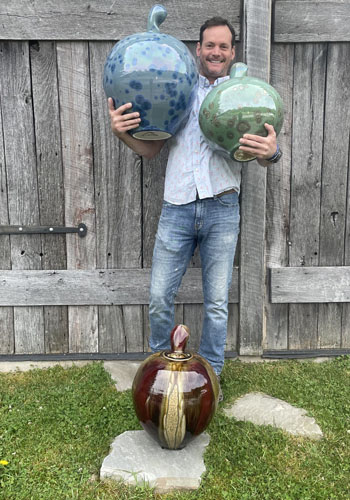
For me, creativity is the implementation of the imagination.
When I am working, my imagination takes hold; images form and shapes appear. Prototypes of the product are spinning in 3-D in my hands, and with the clay and skills I have learned and practiced, I am able to bring that form to life. Sometimes ideas come to me through clients. Most of the time though, it is my mind challenging my skill, pushing the limit of my ability and understanding at that moment.
As I continue to work an idea or form, new challenges are presented, and then instinct takes over—familiarity with the process, the freedom of imagination, and creative problem-solving techniques. The process of working with clay is hard, repetitive, easily derailing, and constantly challenging. Not all ventures are successful, but every one offers a learning and growth opportunity, which is important for my creativity.
BIO: Frank Vickery has been working in clay for over 25 years with multiple years devoted to instruction in clay arts. His ceramic works and teaching approach center around the contributing education model of workshops and dedicated studio hours. Frank started his career as a middle school art teacher in Rock Hill, South Carolina. His graduate work was completed at Western Carolina University, where he earned a Master of Fine Arts degree in 2012. Frank is currently the Director of Ceramics at The Bascom where he also teaches ceramics classes and has a working studio practice. Frank is known for the quality of his work, his commitment to the field of ceramics and arts community, and his enthusiastic ability to share his talent and knowledge with his students.
Honoring and Serving
DIANE McPHAIL, Author and Painter

As I was working on my Masters in painting, I happened upon Madeleine L’Engle’s Walking on Water: Reflections on Art and Faith. Reading it changed my work and my life. In a nutshell, her premise is that the work is not “yours” but comes to you from somewhere else, asking you to give it birth. If you say yes, your job is to follow the work where it knows it needs to go.
This concept opened the threshold for me into both art and authorship. It has led me along unexpected and surprising paths that both delight and astound me. Images appear in my paintings that I do not intend, but which carry great meaning and have led me into major series of work. Characters in novels have revealed to me tales about themselves I could never have imagined on my own.
The “somewhere else” source of all creativity seems to me to come both from within, perhaps the deep unconscious, as well as somewhere without, perhaps anchored in our deep belonging to a larger whole than we can imagine. This wealth of creative possibility swirls endlessly around us, as vast as the Cosmos. We are embraced in it, but to harness it, we must acquire, often through years of discipline, the fine-tuned skills that honor and serve that creative mystery. Most importantly, we must open ourselves and trust its abundance.
BIO: Diane McPhail is an artist, author, therapist, and retreat leader. Diane holds an M.F.A. in studio art and an M.A. in clinical art therapy. Her Doctorate in Ministry focused on creativity and spirituality. She has served as a gallery director, art therapy director, and taught at the Atlanta College of Art, The Bascom Center for the Arts, and privately. Her work is represented in prestigious private, university, and corporate collections, regionally and internationally. She is also an award-winning author of two historical novels, The Abolitionist’s Daughter and The Seamstress of New Orleans, with a third novel scheduled for release in September of 2024. She has received many awards, including an Award for Literary Excellence from Santa Barbara Literary Journal.
Evoking Beauty in Fresh Ways
CARL TURNER, Painter, Graphic Designer and Illustrator

Creative flow is always happening. It has no beginning and no end. Everything you see and experience is a result of an unseen universal creative flow. Nothing is static. Nothing ever stands still, so in reality our entire life and everything in it is a creative act.
As an artist, specifically a painter, I choose to participate in that creative force in a very particular way. Using paint, I tune into that creative force in order to make something visible that was not previously visible.
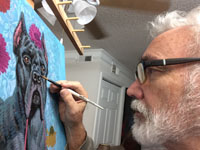
What sparks the creative process for me as a painter? Often it is an idea that I want to express in a visual form. I try to stick to universal themes. Existential truths. I generally want the viewer’s reaction to be something like, ahhh, yes, that’s how I feel, or yes, that’s so true or even, wow, I’ve never thought about it like that before, but something inside the viewer recognizes it, which evokes a sense of comfort. My intent is always to evoke a sense of beauty, hopefully in a way they’ve never quite seen it expressed before.
Recently, I finished a painting that was inspired by a visit to some friends who live near Brevard, NC. In their neighborhood there are many deer that very casually, very peacefully wander around the place, following their natural patterns, and no one bothers them. They are curious and unafraid, and the whole neighborhood cherishes their presence. I grew up in a family of deer hunters, and my first exposure to deer was as prey I was supposed to kill. I realized early on that I did not share that impulse. I wanted this painting to be an expression of my own feelings about the deer and to serve as an homage to their naturally serene nature.
BIO: Carl Turner attended Atlanta College of Art. He has had a highly successful career as an illustrator, graphic designer, and art director for 30 years. During that time Carl studied oil painting with Daniel Green and Sam Adoquei in New York. He later turned his attention to painting the landscape and has recently begun a series of figurative paintings which he calls “metaphysical allegories.” Carl has also been teaching painting classes for the last 10 years. Works for sale can be seen at www.carlturnerart.com. He is also available for portrait commissions. You can contact him from his website.
Finding the Soul’s Song
PENNY POLLOCK, Encaustic Artist
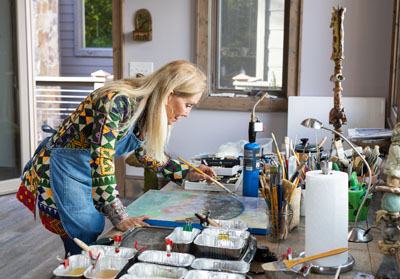
Creativity for me is a thirst, a longing and spiritual response to what I feel and see and wish to express to the planet, be it arranging flowers from my garden, feeding nectar to the hummingbirds and having the gift of their playful visits, cooking a dinner with fresh bounties from the garden and painting to share my expressions of the world around me.
Being imaginative in every facet of my being is what makes my soul sing.
The Highlands-Cashiers Plateau is my most treasured external source of creativity, how could it not be? I am enthralled with the treasures of the creatures who reside among us. Every day I have unexpected sightings of animals and bird life that are the source of inspiration for my work.
My studio is my sanctuary where I go to tackle the job of illustrating and illuminating the gifts that are present in our everyday life and the lessons we as humans can learn from them. I am spellbound by the natural world.
BIO: Penny Pollock is a nationally recognized encaustic artist who chose this medium to merge her history of working in fashion with textiles and shapes. She combines materials and colors to produce clothing and accessories for name-brand lines. Her fascination with indigenous cultures led her to travel the world, collecting bits and pieces of tribal art created by the Maasai of East Africa, the Berber tribes of the Sahara, and the woven and embroidered fabrics of India and Bhutan. Her collection of exotic jewelry, artifacts, relics, and spiritual talismans are ever-present themes in her work.
The Interplay of Art and Craftsmanship
JOHANNES KLAPDOHR, Chef

Creativity is a gift. It is a form of liberation from all that is predictable and normal. It gives me the spark to transform ordinary things into the exciting and unexpected and to find unique solutions to challenges. In my mind, creativity is constantly in motion. It never stops. I never stop thinking and imagining.
As a Chef, I have the privilege of showing my personality on every plate because my approach to food is unique to me. The most wonderful reward is when people recognize the difference of flavor combinations, the artistry of presentation, the attention to detail, love and passion that go into my creations. It is a soft communication tool, unassuming and without prejudice. It is a celebration of individuality, diversity, originality and each other.
Creativity comes from being alive, from love and from passion. Just look at the diversity of cultures around the world. The different ways people live, love and celebrate food is an endless fountain of inspiration. Combine that with a true appreciation of nature, with all its bounty and variety, and you have the most wonderful ingredients for creativity. It could be a conversation, a delivery of fresh products, a moment of failure or success, a nature walk or hike, a tragedy or joyful event, traveling, reading, watching, listening or anything that activates the senses. However, for me, the most creative moments come from a place of happiness, appreciation and solitude.
In Germany, where I am from, we have a different name for profession: Beruf. Beruf means calling. It is what you are supposed to do in life based on your inherent nature, talent, passion and loves. For me, it is all things food. But creativity alone and unchecked does not get the job done. A great Chef I once worked for said it best. “As a Chef you are neither an artist nor a craftsman. You are both!” If one overtakes the other, it creates an imbalance that inhibits success and sustainable creativity. Craft and art need to be in unity and must complement each other. Creativity solely for the purpose of being creative has no purpose. It should be used with wisdom, a balance between the unlimited possibilities of imagination and restraint, logic and reason.
BIO: Chef Johannes Klapdohr was born in Germany into a family of four generations of Chefs. After culinary school, he studied in some of the finest hotels and Michelin star restaurants in the world. In 1996 he became Chef de Cuisine at Nikolai’s Roof, Atlanta’s well established and finest award-winning restaurant. He quickly earned a place in the best 100 Restaurants in the US and the Mobile four-star award. In 2004, he became the Executive Chef of The Lodge at Sea Island, the Mobile five-star, AAA five diamond hotel on St. Simons Island. From 2007 to 2009, he joined the Culinary Vegetable Institute and The Chef’s Garden, one of the leading sustainable farms in the US. In 2009, he moved to North Carolina as Executive Chef of the prestigious Old Edwards Inn. In 2016, he partnered with Marvin and Helene Gralnick to open the Library Kitchen & Bar in Cashiers.
Curiosity and Fearlessness
KAT FORD, Freelance Artist, Designer and Author
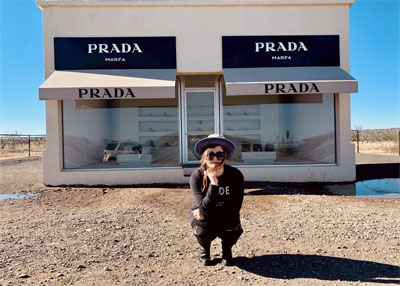
Creativity is an inherent and involuntary function of human existence, manifesting in countless physical forms. The creative process is in artists' brushes and writers' pens, but also in parents' guidance and leaders' decisions. Creativity is the most valuable and least-valued commodity in the world. Wealth can employ portions of creativity, but creativity is limitless, can amass fortune, and build new worlds.
Creativity is a faceted prism, bending the abstract energy of experience and curiosity. It refracts emotions, learning, and skill into a rainbow of opportunity, and, like a precious gem, the greater the number of facets, the more brilliant the result.
In a way, creativity is like a muscle—frequent use increases strength. Perhaps more important, though, is fearlessness. Creativity lends itself to uniqueness. Often, we strive to compare ourselves to others' talents, successes, or processes. Creativity is a still, small voice, equal parts revelation and revolution. To harness creativity is to understand the calling to bring a portion of that voice to life, learn to heed it, and conquer self-doubt long enough to act.
BIO: Kat Ford is a freelance artist, designer, and writer. She was the inaugural editor of Plateau Magazine, has written and illustrated two children's books, and is working on a young adult fantasy novel. Her art has been featured in publications and galleries across the Southwest, including Cowboys & Indians Magazine and during Texas Antique Week in Round Top, TX. Her wardrobe and prop designs are used in special events, music videos, editorial photoshoots, and ad campaigns internationally. www.katherineford.com.
Mastery and Expression
MASE LUCAS, Painter
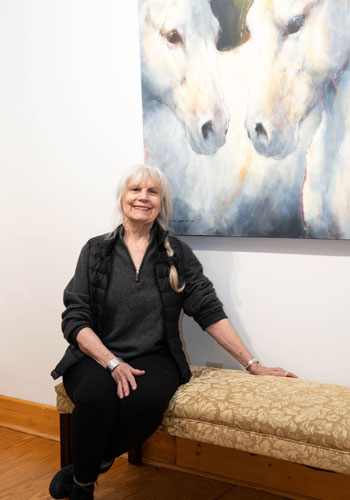
I’m guessing creativity comes from a place in the human intellect. Intellect seems to be a part of the mind more highly developed in humans than other species. I'm thinking here of creativity not born of survival (i.e., the elaborate displays other species create to facilitate breeding or to capture food prey).
For me, there is little distinction between creativity and the ability to harness it. Harnessing creativity is the means by which it is expressed. One may express it musically by mastering an instrument or one's voice, visually by mastering a visual art like painting or film making, or by mastering the use of words.
I do not use the word “mastering” lightly. It is the artist’s responsibility to do the work. An idea without expression is just an idea. Creativity in and of itself is not enough. It is the actualization of that idea that is creative. The intellectual urge to create is manifested by mastering a means by which to express it.
BIO: Mase Lucas has been a studio artist for over 40 years. Her work has been widely exhibited nationally and is in private and corporate collections throughout the United States, Canada and abroad. For more than 20 years, she has been an award-winning regular on the national arts festival circuit. She is most well known for her animal paintings, at the heart of which is the observation that all sentient species possess basic emotional similarities. In her paintings, she hopes to encourage understanding and a sense of responsibility toward all animals, domestic and wild, that for better or worse, live their lives at our discretion.
Surrendering to the Magic
CHELSEA CRONKRITE, Photographer
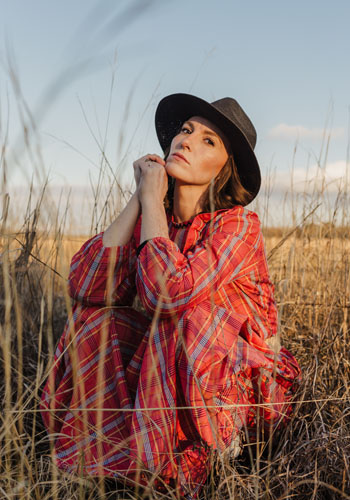
For me, creativity is an active emotion that truly feels like it consumes my entire being. I could be some place exciting and new or in the same spot I sit in almost every night before bed, and my creative brain will show up demanding to be fulfilled. Sometimes it feels like adrenaline, and other times it feels like I’m drowning. It’s all dependent on what’s being laid out in front of me to capture or create.
I believe my creative energy comes from within, but I can also say it’s influenced by life’s happenings. It shows up at the most random times—and it’s definitely inconsistent. Sometimes it almost feels inconvenient, but it’s always liberating once I complete the quest for whatever I’m trying to make happen.
When the creative genius side of my soul shows up, I don’t deny it the space it needs anymore. These days I realize that I need to totally give in to allow the real magic to happen.
BIO: Chelsea Cronkrite is a documentary and lifestyle photographer and chalk artist born near the Atlantic coast, off Florida on the beaches of Flagler, and was raised in the mountains of western North Carolina. She is a mother to two outstanding females and proud wife of a tradesman. Chelsea is known in the creative world for timeless portraiture and documenting authentic moments. She also specializes in editorial work with local magazines and tourism guides.
Conclusion
Having had many hours to reflect upon these answers, searching for both commonalities and distinctions, I am left with the feeling that a willingness to be curious is key to creativity. It may come to each of us through a different path but, however it arrives, we must lean into it. We must listen. Then, once we have heard what it has to say, we must put our heads down and do the work.
When I spoke with Ron Rash for this story, he said something that stuck with me. “As children, we all enjoy this sense of wonder. One minute my grandson is fully inhabiting life as a donkey and then, quite suddenly, he is a pirate. The flow is seamless, if nonsensical. Perhaps artists do not lose this sense of wonder.” I will take that one step further. Perhaps this sense of wonder is never truly lost. Rather, it is waiting patiently for each of us, hoping to be rediscovered, ready to inspire.
On a final note, I found it hard not to get distracted by the science of creativity, especially when I discovered a remarkable consistency between the primary side of the brain used for a particular art and that artist’s belief about the source of creativity. But that is a story for another day. Today, we focus on the magic of creativity.


